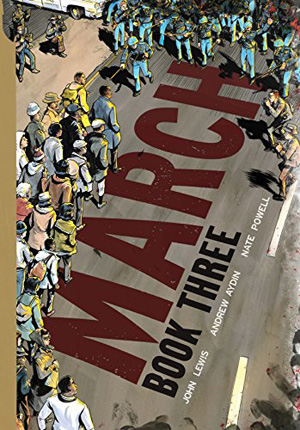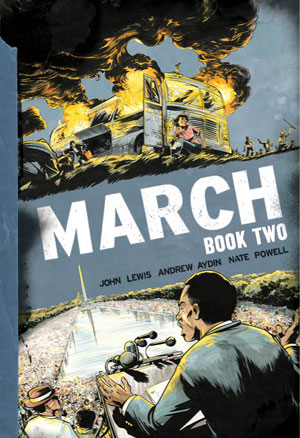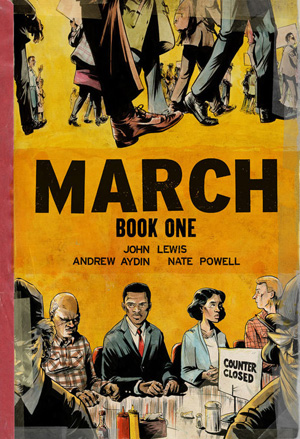Good Trouble
This has been an overwhelmingly rotten year, and if we needed another reminder of that fact, it came Friday night when we learned that John Lewis, civil rights icon and one of the best damn people anywhere, had died at the age of 80.
I suspect y’all will remember that Lewis wrote his own graphic novel, “March,” co-written with Andrew Aydin and illustrated by Nate Powell. I’d previously reviewed Book One and Book Two, but I was surprised to realize I’d never reviewed Book Three — it was released after I’d mothballed the blog in 2016.
So there’s probably no better time to remedy that situation than right now. Let’s look at March, Book Three by John Lewis, Andrew Aydin, and Nate Powell.

In 1963, the civil rights struggles become more violent, largely because white supremacists were getting more and more frightened and angry. The book opens with the terrifying bombing of the 16th Street Baptist Church in Birmingham by the KKK that killed four girls. While much of the rest of the country is horrified, whites in the Deep South are largely ecstatic.
From here, Lewis recounts a lot of tough times for the Civil Rights Movement — attempts to register voters in the South that were obstructed by police, judges, and politicians; the death of John F. Kennedy, one of their major supporters; the murders of Mickey Schwerner, Andy Goodman, James Chaney, and far too many other activists; the futile struggle to seat the Mississippi Freedom Democratic Party delegates at the Atlantic City Democratic Convention.
And Selma. The campaign to register voters, opposed with fanatical rage by the police. The brutal Bloody Sunday at the Edmund Pettis Bridge, where Lewis was savagely beaten by police. And the march from Selma to Montgomery.
And finally, the Voting Rights Act of 1964. But the battle didn’t end there.
And the book isn’t a dry recounting of historical events. Lewis tells you the people he worked with, the disagreements, the small moments between friends, the events that mattered, the speeches that drove civil rights forward. Lewis shares meetings with Martin Luther King, Malcolm X, Fannie Lou Hamer, C.T. Vivian, also gone last week, and dozens more. It’s not textbook history — it’s human history, recreated before your eyes.
Verdict: Thumbs up. Lewis brings us the terrors and triumphs of the Civil Rights Movement on a fully human scale. You’re gonna see a lot of stuff in this book that will make you absolutely furious, from the various bigoted sheriffs committing assaults and murders at will (Golly, how the times do repeat themselves) to LBJ, who, though he may have signed the signature civil rights legislation, was still a racist douchebag.
Luckily, you’ll also see plenty of stuff to inspire you, too. Fannie Lou Hamer’s testimony, Lewis’ trip to Africa and meeting with Malcolm X, the march to Montgomery, all the people working together to bring about a more equitable world.
Lewis decided he wanted to write this because he wanted to educate young people about the struggle for equality and the right to vote — but parents should be aware that the book is full strong language and violence. It’s not gratuitous — this is the language white racists used. And the violence is not gory, but the smudged and shadowy depictions of assaults and fires and bombings are their own kind of nightmare fuel.
But even if you’re worried about showing it to your kids, you shouldn’t be afraid of reading it yourself. When I was growing up, my history classes always petered out not long after World War II. The Civil Rights Movement was glossed over, at best. So reading this is a valuable education for adults as well as kids.
This one is highly recommended. Go read it. Go read all three books of this series.
Comments off


